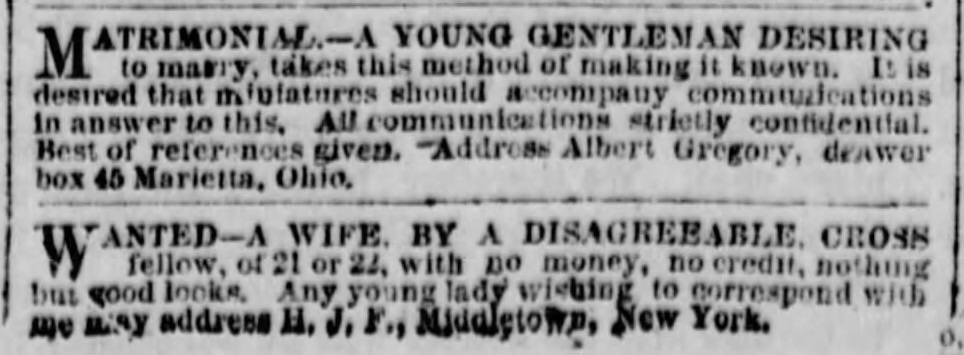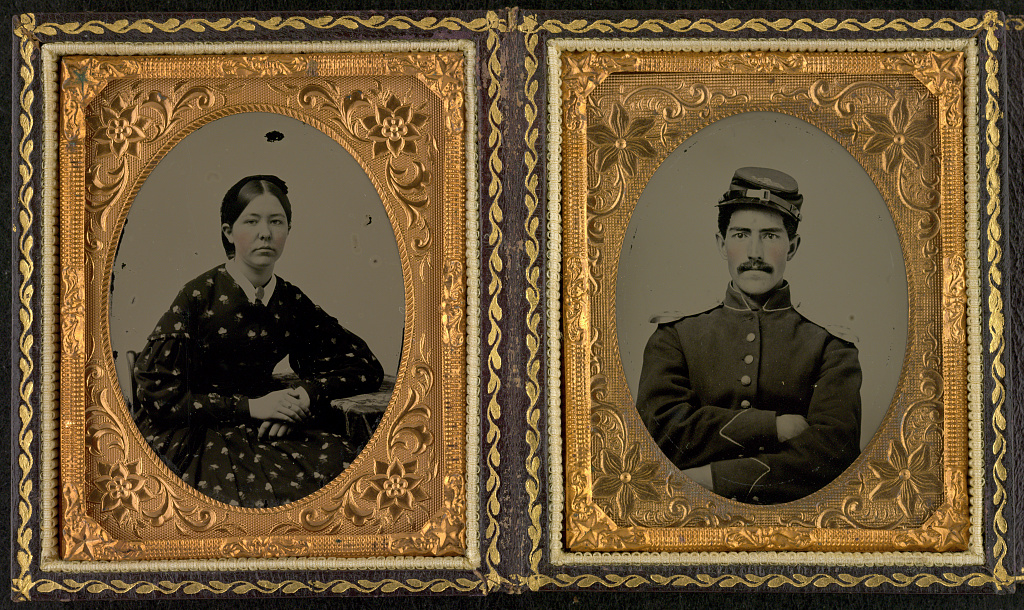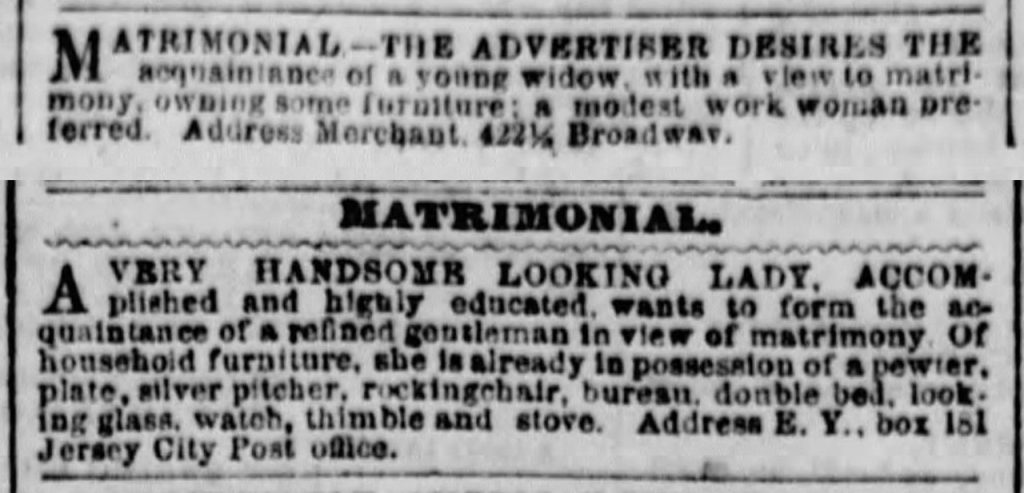Matrimonials: Civil War Era Love and Distance Matchmaking
Finding love in the Civil War era could be tough. Despite the vast urbanization and ongoing industrialization of the mid-nineteenth century, most people in the United States lived in small communities or rural farms. When it came to matchmaking, for many there were only so many options, especially considering the norms and expectations of the Victorian era. The Civil War exacerbated this, as millions of young men left their homes for the military. Many departed for the front with hasty marriages or the promise of one upon their return, but many more enlisted with no sweetheart to write to. The problem was just as big for young women, as most age-appropriate men were off fighting. To find true love, a small number of men and women turned to the equivalent of today’s online blind dating websites and phone apps: newspaper matrimonials.
Newspaper matrimonials were printed in several cities throughout the United States Civil War, but most were concentrated in the New York Herald. The simple system began before the war but skyrocketed in popularity during the conflict. One paid for an advertisement in the matrimonial section of the paper, listing personal characteristics, what type of person they were seeking, and where they could be written to. Advertisements could range from being very broad and open to extremely specific. Often, letters were directed to be mailed to an intermediary who would then forward them to the intended recipient on the front lines or the blockade. Almost all requested the forwarding of a photograph of the woman writing. Many advertisements used pseudonyms to hide their identities and the phrase “any communication accompanied with carte de visite will be treated as strictly confidential” was commonplace.[1]

Some matrimonial advertisements were made without the desire of marriage. For soldiers in the army or sailors on blockade duty, letters from home were morale builders – or in the case of those not receiving anything, morale crushers. Men at the front with no one to correspond could become dejected. One Captain L.B. posted a matrimonial in early 1862 seeking “to relieve somewhat the monotony of camp life, and add much to the happiness of one who has gone forth in his country’s defense;” the same text also appeared on behalf of a Lieutenant M. Dromore at the same time in a Chicago paper.[2] Another man, a Lieutenant H.V.A., fresh from exchange as a prisoner of war, was “desirous of forming a correspondence with some lady for the purpose of cheering his drooping spirits.”[3] Perhaps these soldiers simply wanted pen pals to justify their wartime sacrifices.
For other men, they were willing to entertain any callers. One Oliver C. Banks explicitly wrote in his matrimonial that he sought a “maid or widow” and that “beauty is not particularly desired.”[4] Another man calling himself H.J. F. had perhaps the most desperate plea for a wife: “Wanted – A wife by a disagreeable, cross fellow, of 21 or 22, with no money, no credit, nothing but good looks.”[5]

Just because these men sought someone to end their loneliness did not mean they were open to anyone. Some matrimonial advertisements were specific in who was desired, or who was not. One W. DeLeon, who claimed to be “a young naval officer, of excellent family and associations” serving on USS Minnesota, specifically noted in his matrimonial that “Irish or German aristocracy need not apply.”[6] One H.H.H., advertising as a 30-year-old man, was extremely specific, desiring to communicate with “some young lady or widow, under 22 years of age, of an ardent and lively temperament, agreeable in manners, and prepossessing in appearance.”[7]
Women also posted matrimonials, through their motivations were more varied than that of soldiers relieving boredom or seeking a postwar match. Some desired the security of a husband who could immediately provide, such as one 18-year-old woman who advertised a matrimonial after she was “unexpectedly thrown upon her own resources” after reaching New York.[8] Another woman was clear in her desire for a “true Union man.”[9] Just as men preferred matches from certain backgrounds, women also excluded groups. One “respectable American widow” listed “American or Spanish preferred” on her advertisement.[10] Another, a Philadelphia widow identifying herself only as L.M.C. insisted any potential courter not “indulge in tobacco and liquor,” as “happiness and virtue will never bless such deluded mortals.”[11] Many matrimonials from women called for only war veterans to reply.

Some partook in matrimonial advertisements because they were not inclined to abide by traditional marriage norms of the Victorian era, and this was one of the few ways their desires could be anonymously projected. In September 1864, a woman going by Mattie listed one quality from a desired man in her matrimonial ad: “Only those who can appreciate a true woman in every sense of the word” need apply.”[12] In another, a wartime widow of “ample means” was explicit in her desires to control her situation. “As money is no object,” she wrote, “the gentleman is expected to be handsome, of pleasing appearance and an amiable companion.”[13] These more modern views were advertised by men as well. One widower desired a “matrimonial alliance with a lady of good social position” who would then “remain under her own control.”[14]
Companies quickly took advantage of these matrimonial advertisements. Soon enough, next to the matrimonial ads were others promoting books with promising titles such as Whispers for a Bride that contained “instructions for courting.”[15] These matrimonial advertisements also drew scam artists. Buffalo’s Evening Post condemned anyone answering them as “fools,” citing the experience of one New York woman “who answered a matrimonial advertisement ‘just in fun,’ [and] found she had got into the hands of a sharper whose purpose was to extort money.”[16] A Brooklyn paper cautioned women to avoid the “tricks of a ‘Matrimonial Advertiser,’” hoping to assist in “exposing their scoundrelism.”[17]

Given the pseudonyms, go-betweens, promises of confidentiality, and chance of fraud, determining whether anyone successfully found a life partner through these newspaper advertisements is nearly impossible. However, one can imagine that this last pair of oddly specific advertisers hopefully found one another. The first was a man writing a matrimonial in the New York Herald on March 23, 1864. In that ad, he expressed a desire to meet “a young widow, with a view to matrimony, owning some furniture.”[18] Eleven days later, the same newspaper ran a matrimonial of a “very handsome looking lady” who listed household furniture she already owned, including “a pewter plate, silver pitcher, rockingchair, bureau, double bed, looking glass, watch, thimble, and stove.”[19] In a war of unprecedented suffering and destruction, one can hope they were one another’s true match, read each other’s matrimonial, got together, and lived happily ever after.
Endnotes:
[1] “Matrimonial – The Advertiser Wishes,” New York Herald, New York, NY, March 16, 1864.
[2] “If Any Young Lade Desires to Correspond,” New York Herald, New York, NY, January 31, 1862; “Matrimonial – A Respectable Young Soldier,” Chicago Tribune, Chicago, IL, February 12, 1862.
[3] “An Officer Who is Suppering,” New York Herald, New York, NY, January 24, 1862.
[4] “Matrimonial – An American Gentleman,” New York Herald, New York, NY, October 21,1861.
[5] “Wanted – A Wife,” New York Herald, New York, NY, February 5, 1862.
[6] “Matrimonial – A Young Naval Officer,” New York Herald, New York, NY, February 10, 1862.
[7] “Matrimonial – A Bachelor, 30 Years of Age,” New York Herald, New York, January 31, 1862.
[8] “Matrimonial – A Young Lady,” New York Herald, New York, NY, January 31, 1862.
[9] Matrimonial – A Young Lady,” New York Herald, New York, NY, March 31, 1863.
[10] “A Highly Respectable American Widow,” New York Herald, New York, NY, September 9, 1861.
[11] “A Lady Who Has the Grace,” New York Herald, New York, NY, October 16, 1861.
[12] “A Young Lady,” New York Herald, New York, NY, September 13, 1864.
[13] “A Widow Lady, 24 Years of Age,” New York Herald, New York, NY, November 23, 1862.
[14] “A Widower of Middle Age,” New York Herald, New York, NY, October 21, 1861.
[15] “Matrimony Made Easy,” New York Herald, New York, NY, August 21, 1863; Matrimonial – Whispers to a Bride,” New York Herald, New York, NY, August 21, 1863.
[16] “Matrimonial Advertisements,” Evening Post, Buffalo, NY, December 5, 1863.
[17] “Matrimonial Advertisers,” Daily Eagle, Brooklyn, NY, May 13, 1865.
[18] “Matrimonial – The Advertiser Desires,” New York Herald, New York, NY, March 23, 1864.
[19] “A Very Handsome Looking Lady,” New York Herald, New York, NY, April 3, 1864.